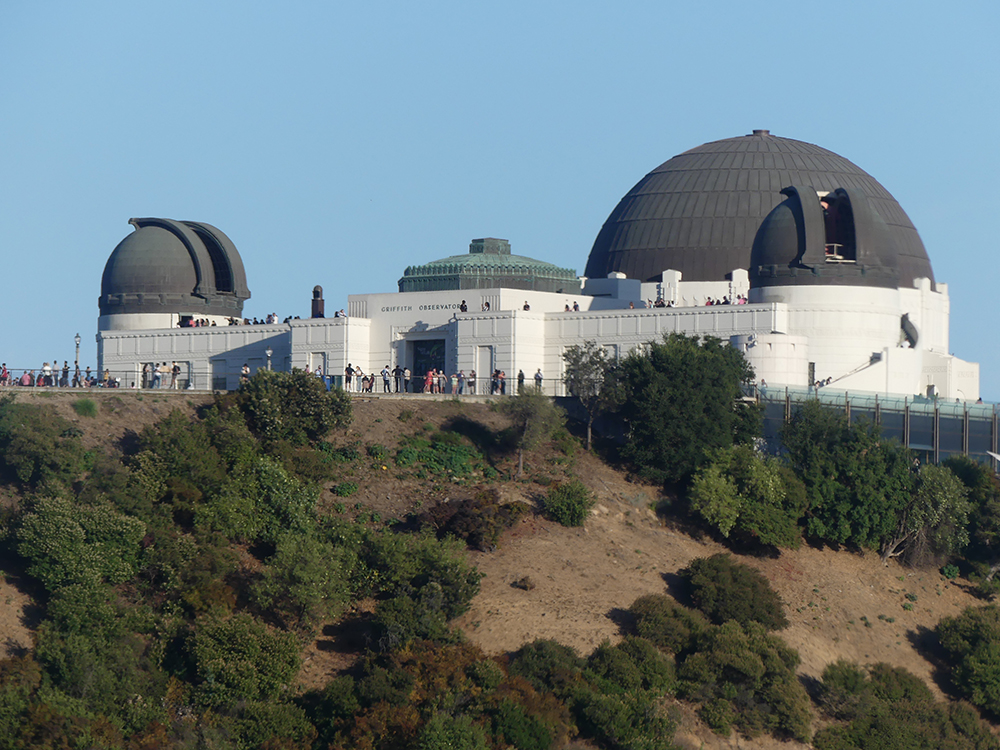LA-Event - Griffith Observatory : A Celestial Landmark and Beacon of Public Science
By Mulder, Los Angeles, Observatoire Griffith, 20 july 2024
Griffith Observatory : A Celestial Landmark and Beacon of Public Science
Los Angeles, Griffith Observatory July 20 2024
The Griffith Observatory, perched high above Los Angeles on the southern slope of Mount Hollywood, is one of the city's most beloved landmarks and a beacon of public science education. Since its opening in 1935, the observatory has served as a gateway to the cosmos for millions of visitors, offering unparalleled views of the universe and the sprawling cityscape below. With its rich history, iconic architecture, and commitment to making astronomy accessible to all, the Griffith Observatory continues to inspire awe and curiosity among locals and tourists alike.
The idea for the observatory was conceived by Griffith J. Griffith, a wealthy philanthropist and visionary who believed that astronomy should be accessible to the general public. In 1896, Griffith donated 3,015 acres of land to the city of Los Angeles to create Griffith Park, with the stipulation that an observatory and planetarium be built atop one of the park's hills. Griffith's vision was to create a space where people could come to learn about the stars and the wonders of the universe without the barriers often associated with scientific institutions. Although Griffith did not live to see his dream realized, his legacy lives on through the observatory that bears his name.

The Griffith Observatory's design, a blend of Art Deco and Greek Revival architecture, was the work of architect John C. Austin. The building's iconic white façade, copper dome, and grand entrance have made it a recognizable symbol of Los Angeles. Upon its opening in 1935, the observatory was an immediate success, drawing large crowds eager to explore the exhibits and gaze through the observatory's telescopes. Over the years, it has remained a popular destination, attracting millions of visitors from around the world.
The observatory's mission is to inspire everyone to observe, ponder, and understand the sky. To this end, it offers a wide range of exhibits and programs designed to engage people of all ages and backgrounds. The observatory's main exhibit hall, the W.M. Keck Foundation Central Rotunda, features a Foucault pendulum that demonstrates the Earth's rotation. Surrounding the pendulum are exhibits that explore the concepts of time, space, and the history of astronomy.

One of the observatory's most popular attractions is the Samuel Oschin Planetarium. Known for its immersive shows, the planetarium uses state-of-the-art technology to take audiences on journeys through the cosmos, exploring everything from the formation of stars to the search for life beyond Earth. The shows are narrated by expert presenters who guide visitors through the wonders of the universe in a way that is both educational and awe-inspiring.
Another highlight of the Griffith Observatory is its array of telescopes, which are available for public viewing. The Zeiss telescope, housed in the observatory's main dome, is one of the largest and most powerful public telescopes in the world. On clear nights, visitors can use the telescope to observe celestial objects such as the Moon, planets, and stars. The observatory also has smaller telescopes set up on its terraces, offering additional opportunities for stargazing.

In addition to its exhibits and telescopes, the Griffith Observatory hosts a variety of public programs and events throughout the year. These include lectures by leading scientists, star parties where amateur astronomers share their knowledge with the public, and special events tied to astronomical phenomena like lunar eclipses and meteor showers. The observatory's dedication to public engagement has made it a cornerstone of Los Angeles' scientific and cultural landscape.
The Griffith Observatory is also renowned for its stunning location and panoramic views. From the observatory's terraces, visitors can take in breathtaking vistas of downtown Los Angeles, the Hollywood Sign, and the Pacific Ocean. At sunset, the view is particularly spectacular, as the city lights begin to twinkle below and the sky above transitions from warm hues to deep twilight. This combination of natural beauty and scientific exploration makes the Griffith Observatory a truly unique destination.

In recent years, the observatory has continued to evolve, embracing new technologies and expanding its outreach efforts. In 2002, the Griffith Observatory closed for extensive renovations and reopened in 2006 with upgraded facilities and new exhibits. The renovation preserved the observatory's historic character while enhancing its ability to fulfill its mission. Today, the observatory incorporates digital displays, interactive exhibits, and online resources to reach a broader audience and keep pace with advances in astronomy and science communication.
The Griffith Observatory has also played a significant role in popular culture. It has been featured in numerous films, television shows, and music videos, often serving as a symbol of wonder, exploration, and the pursuit of knowledge. One of the most famous scenes filmed at the observatory is the iconic knife fight in the 1955 movie Rebel Without a Cause, starring James Dean. This association with Hollywood has only added to the observatory's mystique and appeal.

As the Griffith Observatory approaches its 90th anniversary, it remains as vital as ever, continuing to fulfill Griffith J. Griffith's vision of making the wonders of the universe accessible to all. In a world where science and technology are increasingly important, the observatory serves as a reminder of the value of curiosity, exploration, and education. Whether you're a seasoned astronomer or a curious visitor, the Griffith Observatory offers a gateway to the stars, inviting everyone to look up, ask questions, and discover the mysteries of the cosmos.
You can discover our photos in our Flickr page here : https://flic.kr/s/aHBqjBFKeP
Photos and video : Boris Colletier / Mulderville

